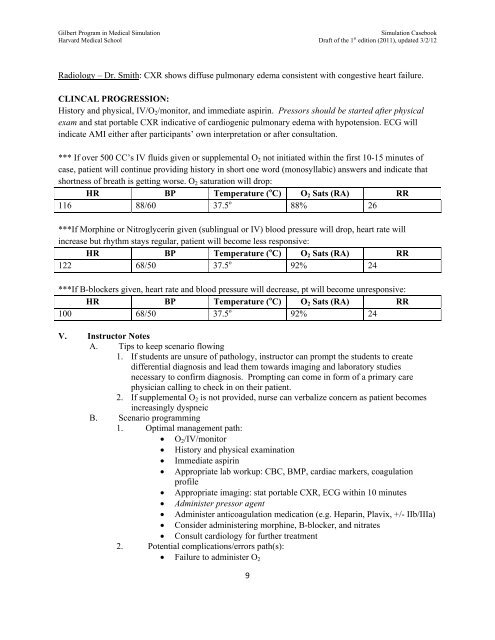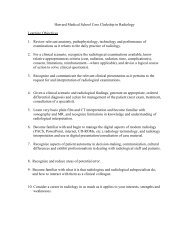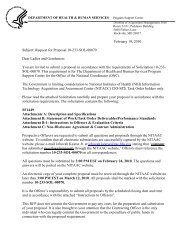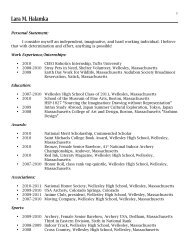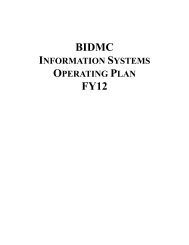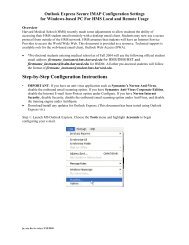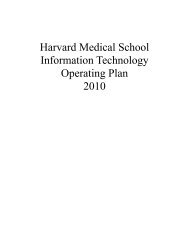SIMULATION CASEBOOK - MyCourses
SIMULATION CASEBOOK - MyCourses
SIMULATION CASEBOOK - MyCourses
Create successful ePaper yourself
Turn your PDF publications into a flip-book with our unique Google optimized e-Paper software.
Gilbert Program in Medical Simulation<br />
Simulation Casebook<br />
Harvard Medical School Draft of the 1 st edition (2011), updated 3/2/12<br />
Radiology – Dr. Smith: CXR shows diffuse pulmonary edema consistent with congestive heart failure.<br />
CLINCAL PROGRESSION:<br />
History and physical, IV/O 2 /monitor, and immediate aspirin. Pressors should be started after physical<br />
exam and stat portable CXR indicative of cardiogenic pulmonary edema with hypotension. ECG will<br />
indicate AMI either after participants’ own interpretation or after consultation.<br />
*** If over 500 CC’s IV fluids given or supplemental O 2 not initiated within the first 10-15 minutes of<br />
case, patient will continue providing history in short one word (monosyllabic) answers and indicate that<br />
shortness of breath is getting worse. O 2 saturation will drop:<br />
HR BP Temperature ( o C) O 2 Sats (RA) RR<br />
116 88/60 37.5 o 88% 26<br />
***If Morphine or Nitroglycerin given (sublingual or IV) blood pressure will drop, heart rate will<br />
increase but rhythm stays regular, patient will become less responsive:<br />
HR BP Temperature ( o C) O 2 Sats (RA) RR<br />
122 68/50 37.5 o 92% 24<br />
***If B-blockers given, heart rate and blood pressure will decrease, pt will become unresponsive:<br />
HR BP Temperature ( o C) O 2 Sats (RA) RR<br />
100 68/50 37.5 o 92% 24<br />
V. Instructor Notes<br />
A. Tips to keep scenario flowing<br />
1. If students are unsure of pathology, instructor can prompt the students to create<br />
differential diagnosis and lead them towards imaging and laboratory studies<br />
necessary to confirm diagnosis. Prompting can come in form of a primary care<br />
physician calling to check in on their patient.<br />
2. If supplemental O 2 is not provided, nurse can verbalize concern as patient becomes<br />
increasingly dyspneic<br />
B. Scenario programming<br />
1. Optimal management path:<br />
O 2 /IV/monitor<br />
History and physical examination<br />
Immediate aspirin<br />
Appropriate lab workup: CBC, BMP, cardiac markers, coagulation<br />
profile<br />
Appropriate imaging: stat portable CXR, ECG within 10 minutes<br />
Administer pressor agent<br />
Administer anticoagulation medication (e.g. Heparin, Plavix, +/- IIb/IIIa)<br />
Consider administering morphine, B-blocker, and nitrates<br />
Consult cardiology for further treatment<br />
2. Potential complications/errors path(s):<br />
Failure to administer O 2<br />
9


